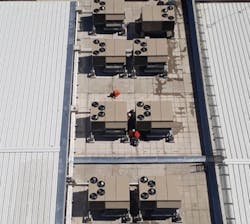Lennox first to meet DOE Challenge for next-gen Electric Cold Climate Heat Pumps
Comfort technology firm Lennox International has been lauded by U.S. energy officials for reportedly developing a next-generation cold climate heat pump as part of the government’s initiative toward building electrification.
The Department of Energy said that Lennox is the first partner in the DOE’s Cold Climate Heat Pump Technology Challenge to reach a key goal. The DOE challenge is to develop electric heat pumps which can operate better in northern winters than current models.
A successful program would shorten the supply chain with domestically manufactured CCHPs, according to the release.
“DOE’s Cold Climate Heat Pump Challenge calls on American businesses to make heat pumps more effective at heating and cooling, more efficient in their energy use, and more attractive options for consumers—so more households can unlock $500 in savings each year on utility bills. With this newest prototype, Lennox has answered that call,” said U.S. Secretary of Energy Jennifer M. Granholm. “Tapping into the emerging clean energy market is a huge economic opportunity that will bring a bolstered manufacturing sector, good paying jobs, and a brighter, cleaner future to Texas and communities across America.”
Lennox is one of nine manufacturers competing in the DOE Cold Climate Heat Pump challenge. Its next-gen CCHP will be tested to demonstrate performance, efficiency and comfort through a full northern winter.
The Lennox prototype reportedly delivers 100 percent heating at 5 degrees Fahrenheit at double the efficiency of previous models. It also delivered 70-80 percent heating at minus 5 and minus 10 degrees, according to the report.
Once testing and demonstrations are completed, product deployment and commercialization are planned by 2024.
Energy use in industrial, commercial and residential buildings account for close to 37 percent of the greenhouse gas emissions in the U.S., according to the federal Energy Information Administration. Within that group, space conditioning (heating and cooling) and water heating account for nearly half of those building emissions, according to the DOE.
The CCHP Technology Challenge was launched last year. the goal is to replace natural gas and fuel oil-type heating sources.
An International Energy Agency report earlier this year stressed that energy efficiency is the "first fuel" in Net-Zero decarbonization goals. Successful efficiency measures could tamp down energy demand 5 percent even in a future economy 40 percent larger, according to the IEA.
Fully activating energy efficiency technologies could reduce CO2 emissions by an additional five gigatons per year just by 2030, according to the report.
-- -- --
(Rod Walton, senior editor for EnergyTech, is a 14-year veteran of covering the energy industry both as a newspaper and trade journalist. He can be reached at [email protected]).





